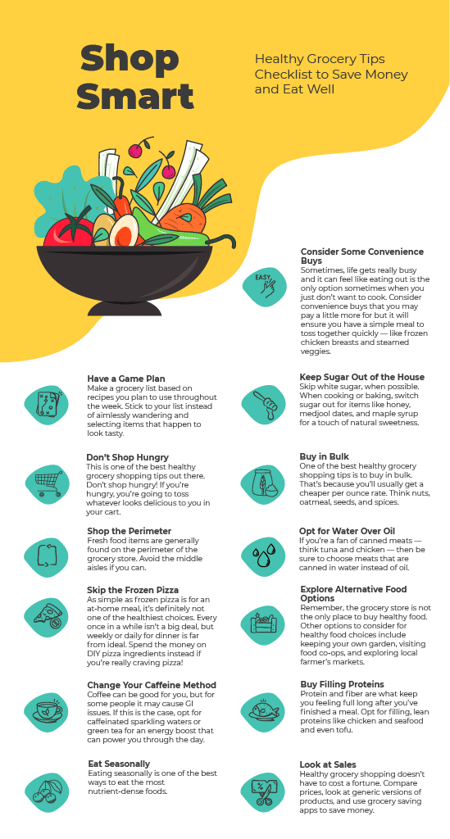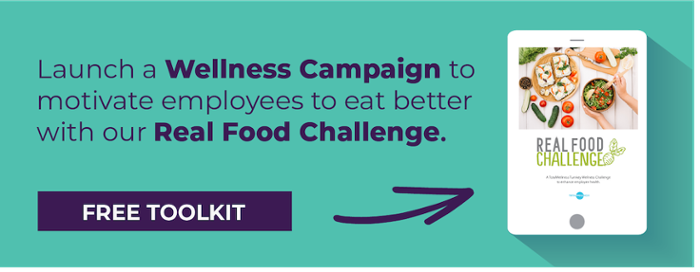Need some healthy grocery shopping tips that also don’t break the bank?
With the cost of everything going up — including groceries – it’s important to remember healthy eating doesn’t necessarily need to be sacrificed. Planning ahead, shopping in bulk, and keeping an eye out for sales are just a few ways to save money and eat healthy.
Want even more ideas for shopping smart?
Read on for tips on ways to save money and shop for foods that are healthy.
Smart Healthy Grocery Tips to Keep in Mind When You Shop
Recently, the U.S. Department of Agriculture (USDA) reported that the Consumer Price Index (CPI) for groceries in 2022 is predicted to rise between seven to eight percent.
In fact, the USDA broke it down even further by showing on a “thrifty food plan” focused on a nutritious diet, that if all meals (and snacks) are prepared at home, a family of four can likely expect to spend around $211.60 weekly for groceries.
Food is the fuel your body needs to operate daily. Like good fuel for a car, it’s important to remember healthy eating impacts how well your body functions. Even with soaring food prices, there are ways to eat well.
Below we offer tips to keep your shopping cart full of nutritious foods that will keep you both satisfied and feeling your best. Check out our 13 tips below.
1. Have a Game Plan
Make a grocery list based on recipes you plan to use throughout the week. Stick to your list instead of aimlessly wandering and selecting items that happen to look tasty. Your wallet will thank you! If you like to be precise, use a calculator on your phone as you shop to see how much the items in your cart are adding up to. You may decide those extra boxes of cookies or other less-healthy snacks aren’t worth it!
2. Don’t Shop Hungry
This is one of the best healthy grocery shopping tips out there. Don’t shop hungry! If you’re hungry, you’re going to toss whatever looks delicious to you in your cart. Consider it a case of your eyes being bigger than your stomach because when you’re hungry your will power is probably much less. This can lead to overspending and tossing random convenience items in your cart that you might not have otherwise picked up.
3. Shop the Perimeter
Fresh food items are generally found on the perimeter of the grocery store. These items are a smart and healthy pick over most of what’s in the middle aisles as it’s fresh and nutrient dense. Lots of the center aisle foods are pre-packaged and often contain preservatives and high levels of sodium which isn’t great for heart health or overall health.
RELATED: Why Is Heart Health Important to Talk About in the Workplace?
4. Buy in Bulk
One of the best healthy grocery shopping tips is to buy in bulk. That’s because you’ll usually get a cheaper per ounce rate. Think nuts, oatmeal, seeds, and spices. You can often find these sections in natural food stores and even big-box grocery stores where you can weigh out your own bulk products. Warehouse stores also offer bulk buying options for items like frozen fruits, veggies, and meats. Just be sure to check your freezer before heading out so you don’t double up on too much!
5. Skip the Frozen Pizza
As simple as frozen pizza is for an at-home meal, it’s definitely not one of the healthiest choices. Every once in a while isn’t a big deal, but weekly or daily for dinner is far from ideal. Frozen pizzas are a convenience food and are often high in fat, calories, sodium, and sugar. Still craving a pizza? Make your own from scratch to control the amount of saturated fat, sodium, and sugar you ingest. A homemade pizza crust made from cauliflower and a few other pantry staples can give you a veggie boost while skipping carbs and unnecessary preservatives. It’s easier than you may think! Just ask Google.
6. Eat Seasonally
Eating seasonally is one of the best ways to eat the most nutrient-dense foods. When you purchase foods in season, you’re opting for food that is more often affordable than produce options that have to be imported out of season. It’s often less expensive and is fresher and tastes better, too.
7. Consider Some Convenience Buys
Sometimes, life gets really busy. If you work long hours, shuffle the kids to numerous after-school activities, or just have a generally jam-packed life, it can feel like eating out is the only option sometimes when you just don’t want to cook. Consider convenience buys that you may pay a little more for but it will ensure you have a simple meal to toss together quickly. For example, pre-cut, frozen chicken breasts and steamable frozen veggies are great examples of convenience buys that are still healthy and sometimes worth the extra cost because they’re time savers.
8. Opt for Water Over Oil
If you’re a fan of canned meats — think tuna and chicken — then be sure to choose meats that are canned in water instead of oil. It’s an even healthier choice if you can find an option labeled no or low sodium to keep your salt intake down. Too much food with high sodium can cause high blood pressure, heart disease, and stroke.
9. Explore Alternative Food Options
Remember, while the grocery store is a convenient way to get your food items for the week, it’s not the only place. Other options to consider for healthy food choices include keeping your own garden, visiting food co-ops, and exploring local farmer’s markets. You may even consider doing neighborhood meal swaps or garden bounty swaps if you’re close with your neighbors.
10. Keep Sugar Out of the House
Sugar is considered an empty calorie that often gets added to a lot of foods unnecessarily. Check labels for added sugar and do your best to avoid those. These items generally don’t offer filling, healthy nutrients, which in turn can lead to overeating because you never feel truly full. Additionally, when cooking or baking, switch sugar out for items like honey, medjool dates, and maple syrup for a touch of sweetness. Unsweetened applesauce can also work as a natural sweetener in some cases.
11. Buy Filling Proteins
Protein and fiber are what keep you feeling full long after you’ve finished a meal. Opt for filling, lean proteins like chicken and seafood and even tofu. Pair it with healthy veggies like steamed asparagus, spinach, or peas for that dose of greens your body needs.
12. Change Your Caffeine Method
Coffee can be good for you, but for some people it may cause GI issues. If this is the case, opt for caffeinated sparkling waters or green tea for an energy boost that can power you through the day. A healthy grocery shopping tip: Skip the cooler by registers that’s often filled with expensive energy drinks. Instead, head down the water/soda aisle where you’ll find many of the caffeinated beverages. Just be sure to watch caffeine content as healthy adults shouldn’t consume more than 400 milligrams of caffeine daily.
13. Look at Sales
Healthy grocery shopping doesn’t have to cost a fortune. While you may spend a little more if you opt to go organic with some produce, it’s often worth it for improved taste, texture, and less chemicals. Check out grocery shopping savings apps to compare prices and look for sales on fruits and veggies — both fresh and frozen.
Take the Time to Shop Healthy to Stay Well
Chances are that if you eat well, you’ll feel well.
Think about how you feel after going through a fast food chain and consuming a heavy, greasy meal. Did you feel light and energetic afterward? Really take note of how you feel after eating certain foods. It will give you insight into what makes you feel your best.
If you groan at the thought of spending money on your “healthier” groceries, consider it an investment in your health. You can invest in smart eating habits now, or you pay the price down the road if your arteries become clogged from one too many unhealthy food choices.
By eating well, you protect yourself from many noncommunicable diseases like diabetes, heart disease, and even cancer. You’ll also have more energy if you’re consuming nutritious foods that offer your body what it needs to keep going.
If you’re curious about eating healthier, here are a few reads you may consider:
The above grocery shopping tips are simply starting points to get headed in the right direction. Once you get the hang of it, you’ll come up with your own methods and styles that work best for you. Here’s to shopping smart and eating well!
What healthy grocery shopping tips do you swear by? Share in the comments below!



